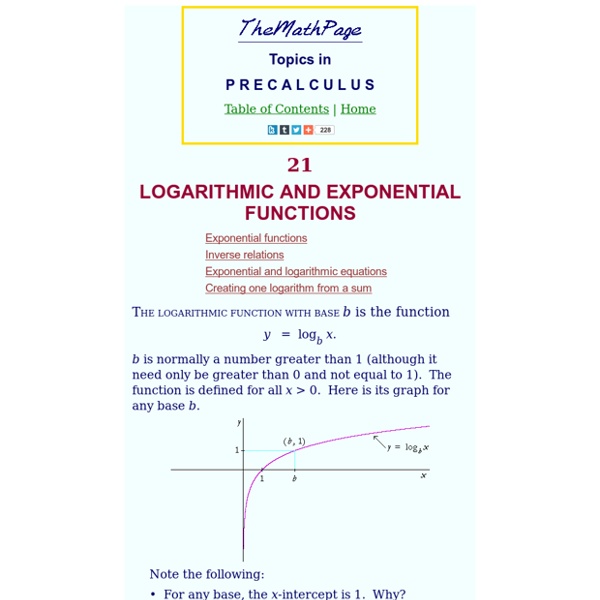Logarithmic and exponential functions - Topics in precalculus

http://www.themathpage.com/aPreCalc/logarithmic-exponential-functions.htm
Basic idea and rules for logarithms - Math Insight
The basic idea A logarithm is the opposite of a power. In other words, if we take a logarithm of a number, we undo an exponentiation.
Exponential and Logarithmic functions
Exponential functions Definition Take a > 0 and not equal to 1 .
Exponential and Logarithmic functions
Exponential functions Definition Take a > 0 and not equal to 1 . Then, the function defined by f : R -> R : x -> ax
Logarithms: Introduction to "The Relationship"
Purplemath offers a complete lessonon the topic you have selected.Try the lesson below! This lesson is not yet availablein MathHelp.com. Logarithms: Introduction to "The Relationship" (page 1 of 3) Sections: Introduction to logs, Simplifying log expressions, Common and natural logs
Logarithmic Functions
The exponential function and the logarithm functions are inverse functions to each other. If we have a logarithm function and if we find the inverse of this, then we have the exponential function. If we draw the graphs of logarithm and exponential function on the line y = x, then we can see that these are the mirror image of each other. For example, for finding the inverse of f(x) = In x, we have to set y = In xInterchanging the role of x and y, we getx = In yex = yf-1(x) = ex
Basic Log Rules / Expanding Log Expressions
Basic Log Rules / Expanding Logarithmic Expressions (page 1 of 5) Sections: Basic log rules, Expanding, Simplifying, Trick questions, Change-of-Base formula You have learned various rules for manipulating and simplifying expressions with exponents, such as the rule that says that x3 × x5 equals x8 because you can add the exponents. There are similar rules for logarithms. Log Rules: 1) logb(mn) = logb(m) + logb(n)
The Change-of-Base Formula
The Change-of-Base Formula (page 5 of 5) Sections: Basic log rules, Expanding, Simplifying, Trick questions, Change-of-Base formula There is one other log "rule", but it's more of a formula than a rule.
Working with Exponents and Logarithms
What is an Exponent? What is a Logarithm? A Logarithm goes the other way. It asks the question "what exponent produced this?": And answers it like this:
Related:
Related:



